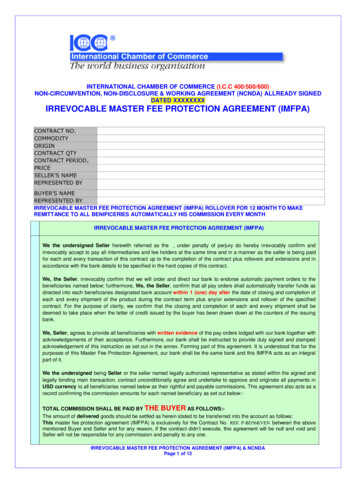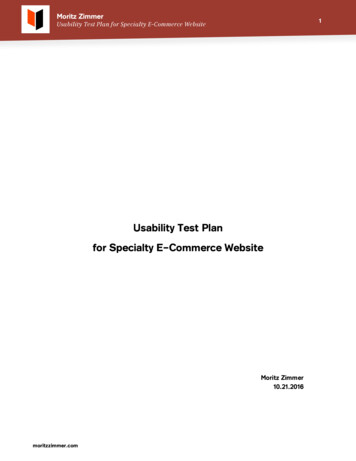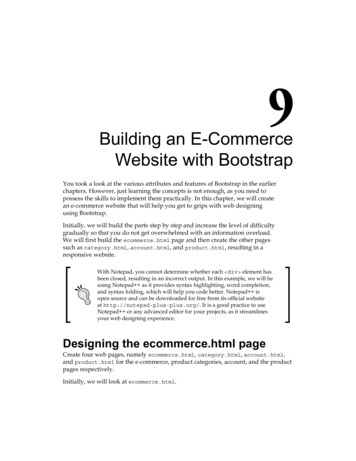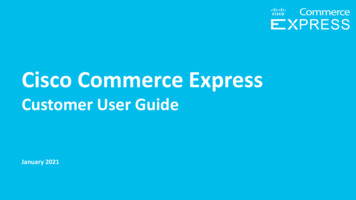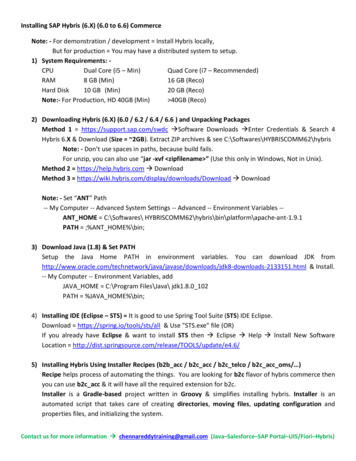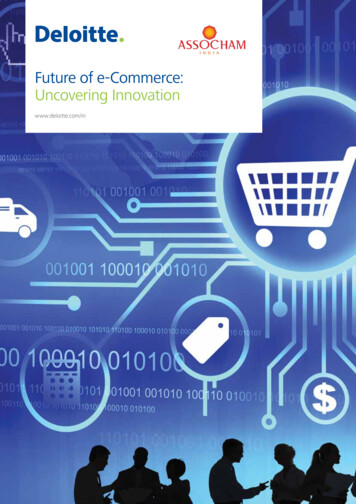
Transcription
Future of e-Commerce:Uncovering Innovationwww.deloitte.com/in
2
ContentsForewordMessage from ASSOCHAMMessage from ASSOCHAMOverview of e-CommerceInnovative and Emerging Business ModelsModern Enabling TechnologiesCyber Security ChallengesTaxation ChallengesThe Way AheadAcknowledgementsAbout ASSOCHAMReferences0405060716202328313536373
ForewordHemant JoshiThe listing of Alibaba on the New York Stock Exchangeat the valuation of 231 billion has brought globalfocus on the e-commerce market. The e-commerceindustry continues to evolve and experience high growthin both developed and developing markets. With theemergence of non-banking players in the paymentsindustry and innovative vertical specific startups, theIndian e-commerce market is expanding at a rapidpace. The digital commerce market in India has grownsteadily from 4.4 billion in 2010 to 13.6 billion in2014 while the global market is forecasted to reach 1.5 trillion in 2014. Increasing mobile and internetpenetration, m-commerce sales, advanced shipping andpayment options, exciting discounts, and the push intonew international markets by e-businesses are the majordrivers of this unprecedented growth.The M&A deals (Softbank’s 627 million deal withSnapdeal, Flipkart acquired Myntra for 370 million,Ola Cabs acquired TaxiForSure for 200 million) andsky-rocket valuation of these e-commerce giants risingin last one year shows that the sector is heating up.The question would be whether these valuations aresustainable despite showing no signs of profitability.The global players like Amazon and Alibaba have deeppockets to rely on their parent companies for continuousfunding support. The homegrown players woulddefinitely need different metrics to preserve the investorconfidence build in the sector.The big retailers are increasingly focusing on their digitalstrategies in order to gain the obvious benefits of onlineplatforms – wider reach, always on, personalizationto name a few. The e-commerce companies areconcentrating their efforts on increasing the penetrationof their mobile apps for higher growth. Big players inthis space claim to have more than 50% of their revenuecoming from mobile apps.4The supply chain and logistics in e-commerce businessare highly complex to manage in a vast country likeIndia where infrastructure is not well-developed toreach every remote and rural area. The taxation policiesfor the e-businesses are not well-defined dependingon different business models and transaction types.The complexity has further amplified with transactionshappening across borders for online selling of goods andservices. Moreover, e-businesses do not take sufficientsteps to deploy a security solution, which is hinderingthe consumer from transacting online.Newer technologies that could significantly bring aparadigm shift in the online businesses are analytics,autonomous vehicles, social commerce, and 3D printing.Companies have started to invest in data analytics togain real-time insights into customer buying behaviorand thus offer personalized user experience. Thee-commerce companies are building communities onsocial media networks to better understand customerneeds and to drive effective marketing strategies.The future of e-commerce is bright and growth willcome from mobile platforms, personalization, socialmedia analytics, omni-channel service, and sharingeconomy business models.The e-commerce industry is an exciting place with theinterplay of social, mobility, analytics, cloud (SMAC),digital, 3D and, virtualization. The current highvaluations, in spite of losses, perhaps, are indicative ofthe future potential.
Message from ASSOCHAMIncreasing internet and mobile penetration, growingacceptability of online payments and favorabledemographics has provided the e-commerce sector inIndia the unique opportunity to fundamentally alter theway companies connect with their customers. Due tothis digital revolution, the e-commerce sector in Indiahas become 4 times its size, from 3.8 billion in 2009to 17 billion in 2014, growing at a CAGR of 37%. Thesector is expected to cross the 100 billion mark withinthe next five years, contributing over 4% to India’s GDP.Online travel, one of the key drivers of India’se-commerce market, accounts for nearly 71% ofe-commerce business in India. Though the online retailmarket in India, currently at 1.6 billion, is a minisculefraction of India’s overall 500 billion retail industry;retail e-commerce has recorded a three-fold growthsince 2011, predominantly driven by million dollarinvestments by domestic and foreign investors.2014 known as the ‘BILLION DOLLAR YEAR’, was criticalfor the burgeoning e-commerce industry with manycompanies attracting private equity investments, whichcatapulted them to billion dollar valuations within lessthan a decade of operations. These valuations furtherdrew interest not only from the conventional VC and PEfirms but also Hedge Funds, Sovereign Funds and evenprivate capital from industry leaders.smart phones is proving to be a game changer, andindustry leaders believe that m-commerce couldcontribute up to 70% of their total revenues.The Government’s ambitious ‘Digital India’ project thataims to offer a one-stop shop for Government serviceswill further bolster the sector by introducing internetand broadband to remote corners of the countryand increase trade. This initiative through a targetedinvestment of nearly 17 billion will transform India intoa connected economy and also attract investment inelectronics manufacturing and create millions of jobs.It is therefore important to overcome challengesin Financing, Infrastructure, Logistics and focus onbuilding Customer Loyalty to usher in the next waveof sustainable growth in e-commerce. Dedicatede-commerce laws are required to address issues in thesector’s legal and regulatory framework and Banksmust play a leading role as ‘Facilitators’ by offering costeffective cash management solutions, secure paymentgateways and other relevant banking services.Rana KapoorPresident, ASSOCHAMManaging Director & CEO,YES BankI am confident that ASSOCHAM’s 4th National Conclaveon E-Commerce India will be instrumental in addressingchallenges in garnering investments into this sunrisesector and ensuring its increasing contribution to India’sgrowth story.On the other hand, mobile commerce (m-commerce)is growing rapidly as a stable and secure supplementto the e-commerce industry. Shopping online throughFuture of e-Commerce: Uncovering Innovation 5
Message from ASSOCHAMIndia is at the cusp of an e-commerce revolution.Although e-commerce has been making rounds in thecountry for over a decade, it is in the recent years thatthe appropriate ecosystem has started to fall in place.Factors like accelerating internet access, staggeringpenetration of mobile phones and robust investmenthave driven the growth of this industry and if currentprojections are anything to go by, India is on route tobecoming the world's fastest growing e-commercemarket.ASSOCHAM has been doing a remarkable job inpromoting e-commerce in India through variousmeasures and events, including the e-commerce IndiaConclave. After massive success of first three editionsof the conclave, it is really a pleasure to know thatASSOCHAM is organizing the 4th National Conclavee-commerce India in New Delhi. I wish them all successin their noble endeavors and I am sure they will keep upthe good work in the field.Bikky KhoslaChairman, ASSOCHAMNational Council one-Commerce & CEO,tradeindia.com6On behalf of ASSOCHAM I would like to thank the teamat Deloitte for preparing a comprehensive white paperon e-commerce in India. The e-commerce industryis one of the fastest growing sectors in the countrytoday, spurring first generation entrepreneurs, largescale manufacturing by SMEs, and most importantlyimpacting the infrastructure growth of the country.The recent Spectrum Auctions, roll-out of 3G and 4Gbroadband services and the National Broadband Planwill certainly usher new business opportunities fore-commerce in the country.We are happy to note that the leading e-commercecompanies are participating in the 4th NationalConclave: e-COMMERCE INDIA to deliberate upon theemerging opportunities in this area.We hope that this paper will be read by all the relevantstakeholders and they will benefit from its extensiveresearch.D. S. RAWATSecretary General,ASSOCHAM
Overview of e-CommerceOver the last decade, the Internet has changed the waypeople buy and sell goods and services. Online retail ore-commerce is transforming the shopping experienceof customers. The sector has seen unprecedentedgrowth especially in the last two years. The adoptionof technology is enabling the e-commerce sector to bemore reachable and efficient. Devices like smartphones,tablets and technologies like 3G, 4G, Wi-Fi and highspeed broadband is helping to increase the numberof online customers. Banks and other players ine-commerce ecosystem are providing a secured onlineplatform to pay effortlessly via payments gateways.The homegrown players have shown tremendousgrowth and attracted some big investors. The entry ofglobal biggies like Amazon and Alibaba has taken thecompetition to a new level. E-tailers are differentiatingthemselves by providing innovative service offerings likeone-day delivery, 30-day replacement warranty, cash ondelivery (CoD), cashback offers, mobile wallets, etc. Thesupply chain has improved significantly and e-tailers areeven leveraging on the services of Indian Post for greaterreach across the country. In 2014, Indian Post collected 2.8 billion through CoD option of payment. 1India slipped from 14th to 20th rank among the top 30developing countries in 2014 Global Retail DevelopmentIndex (GRDI) that looks at measures for retail investmentsworldwide. 2 Chile and China are leading in the GRDIrankings. The sector is still in its growth stage in Indiaand has enormous potential to offer in the comingyears. The government’s most prestigious Digital Indiaproject could take the sector to new heights.Figure 1: B2C E-commerce talDownloadsInventorybasedFuture of e-Commerce: Uncovering Innovation 7
Market SizeThe digital commerce market in India has grownsteadily from 4.4 billion in 2010 to 13.6 billion in2014. As per industry estimates, the digital commercemarket in India is expected to reach 16 billion bythe end of 2015 on the back of growing Internetpopulation and increased online shoppers. Onlinetravel accounts for nearly 61% of e-commerce businesswhile e-tailing contributes about 29%. 3 Visa Indiaspend data showed 53% growth in the number ofe-commerce transactions in 2014. 4Figure 2: Online Retail in India - Market Size ( fSource: IAMAI, Deloitte AnalysisSimilarly, there is an almost similar growth trend ofe-commerce in the global market. The eMarketerreport had predicted that the business-to-consumer(B2C) e-commerce sales worldwide will reach 1.5trillion in 2014, increasing nearly 20% over 2013. 5As the e-Commerce players from the US, Europe andJapan are seeing slower growth in home markets,8they are increasingly looking to enter developingeconomies of India, Brazil and China which haveforecasted growth rates of more than 20% overcoming years. Most popular e-commerce categoriesare non-consumable durables and entertainmentrelated products.
PlayersSeveral players have established their place ine-commerce market just in few years. With the risingdemand of digital commerce, innovative startups areemerging in all segments. Home grown players aretrying to compete head-on with global players whohave the advantage of scale, technology and deeppockets. According to Deloitte’s study “Global Powersof Retailing 2015,” Amazon continues to dominate theworld of e-Commerce with net product sales of 61billion in 2013. Flipkart is the largest e-tailer in Indiawith a valuation of about 11 billion and trying to raisefunds to compete with global biggies like Amazon andAlibaba. Snapdeal is another homegrown player witha valuation of 5 billion. 6 In October, Snapdeal raised 627 million from the Japanese telecom and mediagroup Softbank, who also has a 37% stake in China'se-commerce leader Alibaba. Other emerging playersare – BookMyShow with almost 90% of the onlineentertainment ticketing market; Paytm with almost 20million users is leading provider of virtual wallet.The global e-commerce market is more advancedin terms of technology, awareness, and paymentsystems. Amazon and Alibaba are two big playerswhen it comes to global e-commerce market. Alibabaaccounts for more than 80% of all online purchasesin China and has a global presence. It manages themarketplace and has commission based businessmodel with no products of its own. Amazon, on theother hand, started as online book store and expandedthe business as marketplace and also sells its ownconsumer electronics such as Kindle eBook readers,Fire Tablets, and Fire TV. Only two pure play web-onlye-tailers (Amazon and JD) of the top 50 e-tailers werelarge enough to rank among top 250 retailers.Figure 3: Pure-play e-retailers command top two slots12345678910Amazon.com, U.S. 60,903mn17.7%15JD.com, INC., China 10,826mn66.2%92Wal-mart Stores Inc., U.S. 10,000mne29.9%1Apple Inc., U.S. 9,000mnen/a46Otto (GmBH & co. KG), Germany 8,188mne7.0%70Tesco PLC, UK 5,250mne11.0%5Liberty Interactive Corporation, U.S. 4,884mn10.9%99Casino, France 3,952mn19.4%13Sunning Commerce Group Co., Ltd., China 3,536mn43.9%59Macy’s Inc., U.S. 3,100mne37.8%34 : 2013 e-commerce Retail Revenue in USD millionsTop 250 rankingFY13 e-commerce growth rateSource: Deloitte Global Powers of Retailing 2015 StudyFuture of e-Commerce: Uncovering Innovation 9
Business ModelsE-commerce market in India has started to becomecrowded and complex with several players fightingfor a fair share of customers’ mind and wall
firms but also Hedge Funds, Sovereign Funds and even private capital from industry leaders. On the other hand, mobile commerce (m-commerce) is growing rapidly as a stable and secure supplement to the e-commerce industry. Shopping online through smart phones is proving to be a game changer, and industry leaders believe that m-commerce could contribute up to 70% of their total revenues. The .



